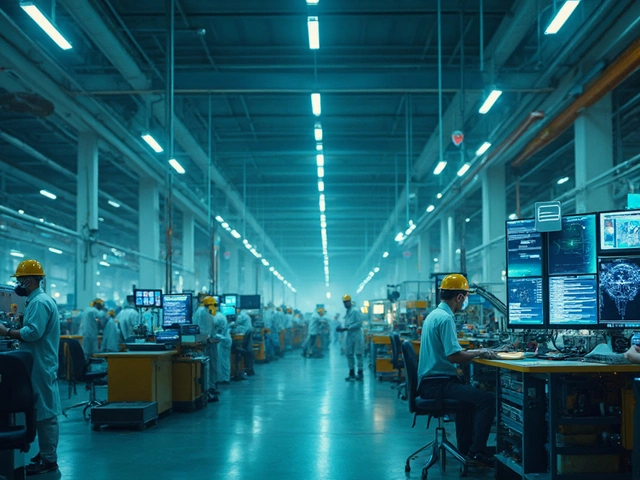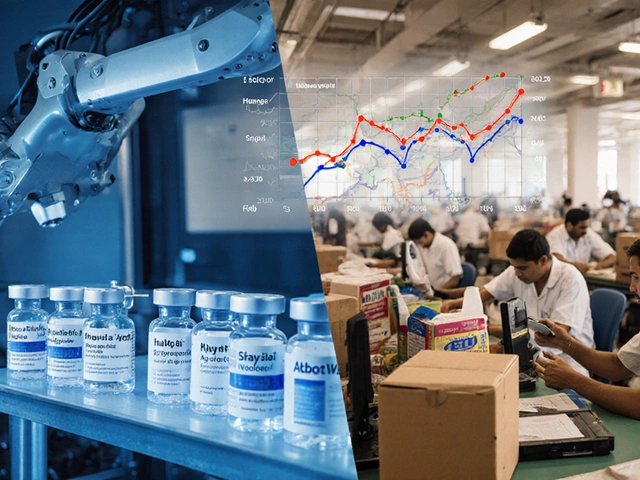
Picture this: the guy behind your fever medicine is probably wealthier than the top Bollywood star. Indian pharma billionaires don't just live large—they steer a chunk of the global medicine market. Guess who tops the list? Dilip Shanghvi, founder of Sun Pharma, has been in and out of the top spot as the richest man in Indian pharma, and sometimes even all of India. If you've never heard his name, that's because pharma tycoons tend to keep a lower profile than tech or Bollywood celebrities.
Most of India's billion-dollar drug fortunes started with small manufacturing units, often run by family. Today, they're pumping out generics and complex meds for nearly every country on the map. Ever noticed the ‘Made in India’ label on your prescription bottle in the US or UK? There's a good chance it traces back to one of these pharma giants.
- Kingpins of Indian Pharma: The Big Names
- How They Built Their Empires
- What Sets Indian Pharma Apart
- Tips for Spotting the Next Pharma Giant
Kingpins of Indian Pharma: The Big Names
If you want to talk about powerhouses in the Indian pharmaceutical industry, a few names always pop up. At the top, you have Dilip Shanghvi, the man who turned Sun Pharmaceutical into India’s largest drug manufacturer. As of 2024, his net worth sits well above $23 billion. Sun Pharma pumps out everything from basic painkillers to advanced cancer meds, exporting to more than 100 countries. Shanghvi started off with five products in 1983—now look at him, leading the pack on the global stage.
Then there’s Pankaj Patel of Zydus Lifesciences, formerly known as Cadila Healthcare. He’s not just a billionaire but has guided Zydus into the spotlight, especially during the COVID-19 pandemic. Zydus rolled out India’s first homegrown COVID vaccine, ZyCoV-D, which marked a big deal not only in India but worldwide. Patel’s knack for innovation keeps the company ahead in vaccines and biosimilars.
Don’t forget Kiran Mazumdar-Shaw, the self-made billionaire who founded Biocon. She started in her garage in the late 1970s making enzymes, and now Biocon is a global name in biosimilars and specialty medicines. Her approach has inspired a whole generation of pharma entrepreneurs, including a bunch of women breaking into a field that’s usually run by men.
Another leader is Yusuf Hamied of Cipla. Cipla is famous for making life-saving drugs affordable, especially HIV/AIDS treatments. Back in the 2000s, Hamied made global headlines slashing the price of antiretroviral drugs for Africa, changing millions of lives. This move didn’t just boost Cipla’s profile, but also gave Indian pharma a reputation for compassion blended with sharp business sense.
Finally, there’s Glenn Saldanha of Glenmark Pharmaceuticals and Satish Reddy of Dr. Reddy’s Laboratories. Both companies are huge on exports and research. Dr. Reddy’s is especially known for launching the first generic version of a key cancer drug in the US—showing just how quickly these billionaires push into international markets.
All these billionaire pharma India leaders have something in common: they started local, but their vision is global. Their companies don’t just follow trends—they set them, proving Indian pharma isn’t just about cheap generics anymore, but also about innovation, impact, and scale.
How They Built Their Empires
Most Indian pharma billionaires didn’t inherit their companies—they built them from scratch, fighting for every contract. Take Dilip Shanghvi, who kicked off Sun Pharma in 1983 with just Rs 10,000 from his father’s savings and focused on psychiatry drugs, which bigger brands ignored. Fast-forward to now, Sun Pharma’s revenue in 2024 topped $5 billion, and Shanghvi is a regular in both Indian and global billionaire rankings.
Another big name is Pankaj Patel of Zydus Lifesciences (once called Cadila Healthcare). He took over the reins from his father and pushed for R&D like no one else. Zydus made headlines in 2021 for launching India’s first homegrown COVID-19 vaccine, ZyCoV-D. This attitude—spotting gaps and innovating fast—runs across these pharma giants.
What really gave these folks an edge? Three things:
- Early focus on generic medicines when Western patents expired
- Jugaad (frugal innovation), finding cheap and effective ways to produce at scale
- Playing big on exports, aiming for the US and European markets for most of their profits
Check out this quick breakdown of the top billionaire pharma founders and their current company size:
| Name | Company | Year Founded | 2024 Revenue (USD) | Key Focus |
|---|---|---|---|---|
| Dilip Shanghvi | Sun Pharma | 1983 | $5B+ | Generics, specialty meds, US/Europe exports |
| Pankaj Patel | Zydus Lifesciences | 1952 (joined 1995) | $2.7B | Vaccines, biosimilars, domestic & global |
| Kiran Mazumdar-Shaw | Biocon | 1978 | $1B+ | Biologics, insulin, biosimilars |
Almost every Indian billionaire pharma India story shares a pattern: small start, strong family backing, an obsession with affordable drugs, and making exports the main event. This practical, gut-driven approach—a mix of hustle and risk-taking—helped these pharma kingpins make global headlines, sometimes even outshining US and European giants in cost and reach.

What Sets Indian Pharma Apart
India isn’t just any player in the medicine game; it’s often called the “pharmacy of the world.” This isn’t just a catchy nickname—about 20% of the global supply of generic medicines now comes from India. You can check the back of hundreds of meds in clinics and pharmacies worldwide and likely see an Indian manufacturer listed.
So, what’s behind all that buzz? First, Indian pharma companies figured out how to make high-quality generics at seriously low costs. They keep overhead down, run massive factories, and invest heavily in R&D to reverse-engineer popular drugs. That’s how they get medicines to people who can’t always afford the expensive originals. This approach is actually lifesaving for millions, especially for critical illnesses like HIV and TB.
Here’s a cool fact: Indian pharma exports hit $25.4 billion in 2023. Around 40% of all medicines sold in the US by volume come from India. No, that’s not a typo. And it’s not just the West—countries in Africa, Latin America, and Southeast Asia depend on these Indian companies for affordable meds every day.
What also makes Indian pharma tick is a strong pool of scientists and engineers. Universities pump out thousands of pharma grads each year, so there’s no shortage of brainpower. Plus, Indian regulations have gotten way stricter, so companies work hard to meet US FDA and EU standards. Indian plants are among the most inspected in the world.
If you like numbers, here’s a quick breakdown of recent pharma export stats:
| Year | India's Pharma Export Value (USD Billion) |
|---|---|
| 2021 | 24.4 |
| 2022 | 24.7 |
| 2023 | 25.4 |
The secret sauce? Indian pharma companies aren’t just competing on price—they’re also pushing into complex generics and specialty drugs. Stuff like cancer meds, or biosimilars, where the science is far trickier than basic tablets. These moves keep the billionaire pharma India names at the top of the global leaderboard.
If you’re eyeing the industry, watch for which companies are getting lots of approvals from the US FDA or launching new types of medicines. That’s usually where the next big wave—and the next Indian pharma billionaire—will show up.
Tips for Spotting the Next Pharma Giant
If you’re hunting for the future stars among India’s pharma manufacturers, you’ve got to look beyond flashy websites and slick marketing. The real secrets show up in what’s actually happening on the ground with companies, products, and exports.
Here’s what helps you spot the next billionaire pharma India story:
- Focus on Exports: The giants almost always have a global reach. Sun Pharma, Lupin, and Aurobindo all started raking in big money when their exports took off. Companies winning more regulatory approvals (from US FDA or Europe’s EMA) are serious contenders.
- R&D Investments: Big spenders in research often lead the pack. For example, Dr. Reddy’s invested 8% of their revenue in R&D last year (over ₹1,600 crore). These guys move fast in biosimilars and new generics.
- Acquisitions and Partnerships: Watch who’s snapping up small companies or making global deals. Sun Pharma’s jump to the top was cemented when they bought Ranbaxy in 2014. It suddenly put them on the global map.
- Niche Focus: Firms specializing in complex generics, biosimilars, or high-barrier drugs are breaking new ground. Biocon’s dedicated push into biosimilars made them global players.
- Compliance Track Record: Companies that fix issues after US FDA warnings, instead of crumbling, are in it for the long haul.
Here’s how some current contenders stack up (2024 data):
| Company | Export Revenue (₹ Cr) | % in R&D | Major Markets |
|---|---|---|---|
| Sun Pharma | 19,000 | 6.5% | US, Europe, Japan |
| Dr. Reddy’s | 11,200 | 8% | US, Russia, Europe |
| Cipla | 10,500 | 6.9% | South Africa, US, EU |
| Biocon | 6,900 | 11% | US, EU, Latin America |
Want an edge? Don’t just read headlines. Dive into annual reports, track new facility approvals, and follow the FDA’s inspection updates. If a mid-sized company is suddenly hiring lots of scientists or chasing patents, they could be lining up for the big leagues. Big pharma isn’t built overnight—watch for those small, consistent wins stacking up fast.




